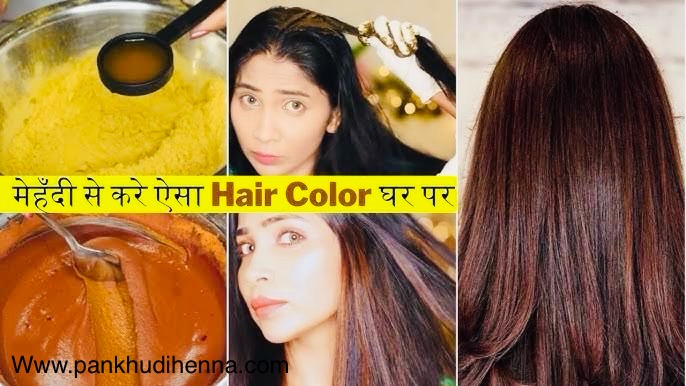
Henna for Hair: A Natural Way to Color and Nourish Your Hair
Henna, also known as Lawsonia inermis, is a plant that has been used for centuries as a natural dye for hair, skin, and fabrics. In recent years, henna for hair has gained popularity due to its ability to provide a safe, chemical-free alternative to traditional hair dyes. Unlike chemical dyes, henna not only colors your hair but also nourishes and strengthens it, making it a popular choice for people looking for a natural approach to hair care.
In this blog, we’ll dive into everything you need to know about using henna for hair, including its benefits, how to apply it, and what to expect when you make the switch to this ancient hair dyeing method.
Benefits of Using Henna for Hair
Henna offers a wide range of benefits beyond just coloring your hair. Here are some reasons why you should consider henna for your next hair treatment:
1. Natural Hair Dye
Henna is a 100% natural product made from crushed leaves of the henna plant. When applied to hair, it deposits a reddish-brown color that can range from subtle highlights to a deep, rich red, depending on your hair’s natural color. Henna is free from harmful chemicals like ammonia and peroxide, making it an excellent alternative for those who want to avoid harsh ingredients.
2. Nourishes and Strengthens Hair
Henna not only colors your hair but also nourishes it. It binds with the keratin in your hair, making each strand stronger. This can help reduce breakage, split ends, and overall hair damage, especially for people with thin, brittle hair.
3. Boosts Hair Growth

Henna helps balance the pH levels of your scalp, reducing oil production and promoting healthy hair growth. Regular use can also help reduce dandruff and other scalp irritations by maintaining a healthy scalp environment.
4. Adds Shine and Volume
One of the best things about henna is the way it enhances your hair’s natural shine and volume. Henna coats the hair shaft, making it look thicker and shinier without weighing it down or causing buildup.
5. Long-Lasting Results
Henna is semi-permanent, meaning that the color lasts for several weeks, gradually fading rather than causing roots to show. Its long-lasting nature makes it a convenient choice for those who don’t want to reapply dye frequently.
How to Apply Henna to Hair
Applying henna to hair is a simple process, but it does require some preparation and patience. Here’s a step-by-step guide on how to apply henna to your hair for the best results.
What You’ll Need:
- Henna powder (preferably organic and free from additives)
- Lemon juice or water (for mixing the paste)
- A mixing bowl and spoon
- Gloves (to prevent staining your hands)
- Plastic wrap or a shower cap
- Old towel (to protect your clothes)
- Comb and hair clips (for sectioning your hair)
Steps to Apply Henna:
- Prepare the Henna Paste: Start by mixing your henna powder with lemon juice or water in a bowl. Stir until the mixture has the consistency of thick yogurt. Cover the bowl and let the mixture sit for 6 to 12 hours to allow the dye to release.
- Section Your Hair: Before applying the mehndi, section your hair into manageable parts using a comb and hair clips. This will help you apply the henna evenly.
- Apply the mehndi: Wearing gloves, begin applying the mehndi paste to your hair, starting at the roots and working your way to the ends. Be sure to cover each strand thoroughly.
- Wrap Your Hair: Once all of your hair is covered in mehndi, wrap your hair in plastic wrap or put on a shower cap. This will keep the henna moist and help the dye penetrate your mehndi better.
- Wait: Allow the mehndi to stay in your hair for at least 2 to 4 hours. For a deeper color, you can leave it on for up to 6 hours.
- Rinse: After the processing time is complete, rinse your hair with lukewarm water until the water runs clear. Avoid using shampoo for the first 24 to 48 hours after applying henna, as the color will continue to develop.
What to Expect with Henna Hair Color
Henna’s final color result varies based on your natural hair color and the amount of time the mehndi is left in your hair. Here’s a breakdown of how henna works with different hair colors:
- Light or blonde hair: Henna will usually produce a bright orange or copper color.
- Brown hair: mehndi will give a deep reddish-brown color.
- Dark brown or black hair: The effect will be subtle, producing a dark auburn tint that becomes visible in sunlight.
- Gray or white hair: Henna can result in a vivid orange or red color, so it’s often mixed with other natural ingredients like indigo or amla to tone down the brightness.
Tips for Enhancing Henna Hair Color
While pure henna produces a reddish-brown hue, you can experiment with additional natural ingredients to achieve different shades:
- For a darker color: Mix henna with indigo powder to create shades of brown or black.
- For a cooler tone: Add amla powder to the henna paste to tone down the red and give a cooler brown shade.
- For richer red tones: Use hibiscus powder or beet juice for a more vibrant red result.
- For golden tones: Mix henna with chamomile tea or cassia powder to achieve lighter, golden hues.
Henna vs. Chemical Hair Dyes: Why Choose Henna?
When compared to chemical hair dyes, henna stands out for several reasons:
- Natural and Safe: Unlike chemical dyes that often contain ammonia, peroxide, and parabens, henna is a natural product that nourishes the hair rather than damaging it.
- Hypoallergenic: Henna is less likely to cause allergic reactions or scalp irritations, making it a safer option for people with sensitive skin.
- No Fading Roots: Because henna fades gradually over time, you won’t have to worry about stark root lines, as you do with chemical dyes.
- Environmentally Friendly: Henna is biodegradable and free from harmful chemicals that can pollute water and soil, making it an eco-friendly choice.
Frequently Asked Questions About Henna for Hair
1. Does henna cover gray hair?
Yes, henna can cover gray hair, but the color result may be more vibrant. Mixing henna with indigo or amla can help tone down the brightness and create a more natural-looking shade.
2. How long does henna hair color last?
Henna typically lasts 4 to 6 weeks before fading gradually. It’s a semi-permanent dye that will not wash out completely but will soften over time.
3. Can I use henna over chemically dyed hair?
Yes, you can use henna over chemically treated hair, but it’s important to choose a natural, high-quality henna product. Always do a strand test before applying henna to your whole head to ensure the desired color result.
4. Is henna safe for pregnant women?
Henna is considered safe for use during pregnancy, as it is a natural dye without harmful chemicals. However, it’s always a good idea to consult with your doctor before use.
Conclusion
Henna for hair is a wonderful, natural alternative to chemical dyes, offering a way to color your hair while also nourishing and strengthening it. Whether you’re looking for a rich red, a deep brown, or even a black hue, henna allows for endless possibilities in a safe and eco-friendly manner. By switching to mehndi, you can enjoy vibrant, long-lasting color without the worry of damaging your hair with harsh chemicals.
Give henna a try and experience the beauty of naturally colored, healthy hair!
Tags:
Henna for hair, Natural hair dye, Henna benefits for hair, How to apply henna, Chemical-free hair color, Henna for gray hair, Best natural hair dye, Nourishing hair treatment.





